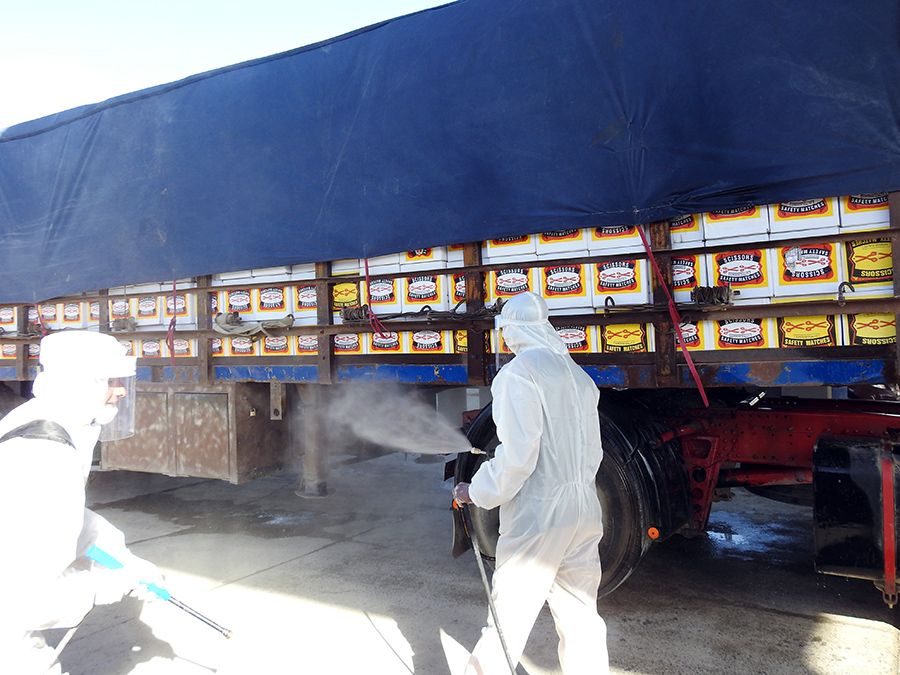Around the world, the advent of COVID-19 has been transformational for market systems-focused development projects. Many of the countries in which DAI works have implemented shelter-in-place orders, creating countless operational challenges as staff reduce or cease in-person interaction with partner firms, households, and other staff members. In addition to operational obstacles, the pandemic has brought about systemic changes to supply chains and transaction processes. Economic slowdowns and health concerns combine to transform consumer demand, shaping preferences and behaviors. As businesses navigate these new realities, they simultaneously struggle to mitigate the risks of infection to their staff, customers, and suppliers.
To better understand how market systems projects funded by the U.S. Agency for International Development (USAID) are addressing these issues, DAI has reviewed 15 economic growth projects that we are currently implementing. While the projects differ in mandate, funding, and interventions dependent on their contracts, they employ similar approaches to confront the following five challenges.
Challenge 1: Assisting Farmers and Agroprocessing Firms to Mitigate the Risk of COVID-19 Transmission
As communities seek to protect themselves from contracting COVID-19, so too do actors within agricultural value chains. For agroprocessing firms, the risk of viral transmission between employees, customers, and suppliers threaten a firm’s workforce and brand perception.
To address these concerns, the Afghanistan Value Chains-High Value Crops (AVC-HVC), the Afghanistan Value Chains-Livestock (AVC-Livestock), and the Regional Agricultural Development Program-East (RADP-E) are implementing on-site COVID-19 training on best practice sanitary measures, complemented by the procurement of sanitary kits. RADP-E, for example, crowdsourced photos, interviews, and videos that show how international agroprocessing firms have adapted their line operations to reduce exposure among employees, raw product suppliers, and customers.
For small farmers, the Mozambique Feed the Future Agricultural Innovations (FTF Inova) project is encouraging output buyers who source from smallholder farms to promote household COVID-19 mitigation. Working with two buyers—Olam International and Miruku Agro-Indústria—FTF Inova has helped establish small farmer supplier clubs to offer premium prices, extension support, and prizes to suppliers that agree to enter long-term supply relationships and respect quality standards.
Another project, the Zambia Scaling-Up Nutrition Technical Assistance (SUN TA) project, is supporting COVID-19 messaging for rural health centers by publicizing social distancing and sanitary practices through television, social media, and pickup trucks fitted with loudspeakers; it is also equipping health workers with bicycles to increase their mobility and reach.
Challenge 2: Helping Firms Cope with Disrupted Supply Relationships
Restrictions on the movement of people now hinder inter-regional transport and disrupt normal commercial routes. Virtually everywhere, rural farmers, traders, aggregators, and retail distribution circuits face pressure to conduct transactions with less face-to-face contact.
Taking advantage of value chain relationships it helped establish prior to the pandemic, FTF Inova is assisting input and output market actors to develop transaction modes that reduce personal contact. For example, the team has been working with Casa do Agricultor, a national ag input supplier—plus more than 150 smaller input retailers—to develop Rota Certa, a pre-order system that will systematize ordering, payment, and weekly delivery of the products the retailer ordered. If successful, this mechanism could allow 13,000 smallholder customers of regional input dealers in Casa do Agricultor’s network, along with approximately 480 farmers linked by village-based agents to other input suppliers, to order, pay, and receive inputs without having to travel to urban areas or engage in more than one face-to-face interaction with a village agent.
Marketing small farmer crops also means addressing supply chain and retail system disruptions in urban markets. For example, FTF Inova partnered with AppLoad, a local software company, to launch an e-commerce application. The firm’s application serves as a matchmaking platform, pairing private users who need to transport goods with participating trucking companies—think Uber for small freight loads. In response to the crisis, AppLoad recently launched a free “Trading Room” product within the app to drive demand for logistics services by helping buyers and sellers of agricultural products conduct their business, since physical markets have been shut down.
Challenge 3: Reaching Project Partners Despite Reduced Interaction
As countries enforce various COVID-19 measures, many market systems projects have been unable to maintain face-to-face interaction with client firms. To address these obstacles, our ag value chain projects in Afghanistan surveyed their main agricultural firm clients by phone to see how they have been affected by the public health measures in effect since April. These interviews provided much-needed data on the firms’ operating status during the lockdown, the major difficulties they have encountered, and the state of raw product input supply and end-product sales. Ultimately, these data were instrumental in developing concept notes on how our programs could pivot in response to the crisis, subsequently accepted by USAID.
Our projects also had to figure out how to deliver technical assistance and training typically conducted in person. One successful tool for getting around these difficulties is the Uzbekistan Agricultural Value Chain Activity (AVC)’s YouTube Channel, Science of Horticulture, which shares extension videos. The channel has received more than 2.4 million views as of April and has tripled its subscribers in the past year to 22,000, most of which have been added in the first quarter. Daily viewership on the channel have soared, and materials shared through YouTube are evidently of great value to communities seeking to reduce potential exposure to COVID-19.
Challenge 4: Helping Small and Medium-Sized Enterprises (SMEs) Adapt to Economic Slowdown
One effect of COVID-19 has been a slowdown in economic activity stemming from reduced consumer spending. In many cases, our projects’ SME partners have been forced into partial or total closure. Under these circumstances, firms face cash flow deficits that reduce their ability to adapt to changing supply relationships and end-market parameters, and even threaten their existence.
To help key partners, DAI’s Afghanistan projects have provided support for firm-level upgrading through grants and other assistance vehicles, such as deal notes, to provide supplies and equipment that enable SMEs to implement COVID-19 mitigation practices and adapt to new market circumstances. Unlike governments in many developed countries, USAID/Afghanistan has not favored subsidizing operational costs or employee salaries. Instead, it is supporting efforts that help firms cover the immediate direct costs of introducing COVID-19 mitigation measures, such as investing in sanitary facilities, employee hygiene kits, and processing equipment and cold storage to handle the increased volumes of fresh produce expected as the pandemic limits access to export markets.

The USAID TradeHub, in partnership with the Lesotho National Development Corporation and in close collaboration with the U.S. Embassy in Lesotho, is piloting a program to support textile and apparel companies in the country to produce personal protective equipment in response to the COVID-19 pandemic. Photo: USAID Southern Africa TradeHub.
The USAID Southern Africa Trade and Investment Hub (USAID TradeHub) and FTF Inova have each made recent proposals to USAID to add grants facilities that will enable them to co-fund similar firm-level COVID-19 investments. In its concept note to USAID, the USAID TradeHub proposed a grant fund to help SMEs during initial disruptions created by the COVID-19 lockdown, followed by subsequent funding tranches to stabilize struggling firms, help them seize new market opportunities, and enhance their competitiveness in a post-COVID environment.
FTF Inova is also proposing to establish a $500,000 challenge grant fund for businesses of all sizes to create innovative solutions to address weaknesses in the domestic supply chain of staple foods. In addition to new funding efforts, the USAID TradeHub is also helping a group of southern African firms looking to export personal protective equipment to repurpose their manufacturing operations and gain U.S. market entry.
The Rwanda Nguriza Nshore project is supporting COVID-19 adaptation through a national public sector concessional loan facility, working with the Rwanda Ministry of Finance and the Central Bank to structure a COVID-19 SME Economic Recovery Fund. Under the plan, the Government of Rwanda will contribute $100 million for the facility and the project will support the capital raise for an additional $100 million, most likely through development finance institutions. The facility will provide concessional loans through select commercial banks. DAI and its core partner, BiD Network, will work with SMEs receiving funds both during and after the loan term to restructure the companies. Support through the fund is expected to begin in the fourth quarter. As the pandemic began to reshape operating realities, Nguriza Nshore also helped essential businesses pursue new distribution channels and reorient toward online systems.
![[1] Masaka Creamery (1).jpg](https://dai-assets.s3.amazonaws.com/blogs/%5B1%5D%20Masaka%20Creamery%20(1).jpg)
Nguriza Nshore has provided support to small firms like Masaka Creamery to reorient them toward online systems during COVID-19. The creamery is also likely to seek support under the Economic Recovery Fund. Photo: USAID Rwanda Nguriza Nshore.
Challenge 5: Overcoming Disruption in International Trade Relationships
Concern about importing COVID-19 has led to stricter border crossing protocols in almost every country. Even where trade has not been entirely cut off, quarantine restrictions on truck drivers result in delays and higher costs—which can be prohibitive to trade in fresh agricultural products that must be done on narrow margins within restrictive timeframes.
These difficulties have been particularly severe, for example, in the Central Asia trade corridor between Pakistan, Afghanistan, and the Central Asian Republics, and the AVC-HVC project has responded through two interventions. In the first, the project is working to introduce on-the-ground improvements at the Torkham and Spin Boldak border crossing points between Afghanistan and Pakistan. At both border posts, AVC-HVC took over the disinfection operations for vehicles through Harakat, an Afghan nongovernmental organization, which enabled the Afghan government to meet the requirements established by the government of Pakistan and resulted in re-opening the borders to trade after a three-month closure. The project’s second intervention is establishing a temporary trans-shipment facility at the Torkham border post to expedite transfer of containers from Pakistani to Afghan trucks. The project has also begun supporting export firms through a 30 percent shipment subsidy to cover transport costs for agricultural exporters that are using new trade routes. This initiative is designed to encourage exports through nontraditional trade routes, helping exporters to diversify their client base and reduce dependence on single border crossings. An $80,000 investment in this subsidy has resulted in exports worth $3.7 million.

AVC-HVC took over the disinfection operations for vehicles through Harakat, an Afghan nongovernmental organization, resulting in the re-opening of borders with Pakistan. Photo: USAID Afghanistan AVC-HVC.
Meanwhile, the Central Asia—Competitiveness, Trade, and Jobs Activity (CTJ) is facilitating cross-border trade through a virtual matchmaking service. This activity—between 35 Central Asian growers and potential buyers representing retailers, importers, and distributors from across Europe, the Middle East, Southeast Asia, and the Commonwealth of Independent States (CIS)—was developed by the project in response to the cancelation of inward buyer missions because of COVID-19 travel restrictions. The virtual matchmaking is facilitated by Kazakh and U.S. export promoters, relying on these promoters to work with producers and buyers to vet suppliers in Central Asia and identify international buyers along their quality and quantity parameters. CTJ works with the export promoters to conduct webinars and individual calls, communicating buyer requirements on standards, packaging, and terms. The export promoters then share information with potential buyers on specific exporters that are selected for their ability to meet the buyers’ terms.
Though it is too early to assess the results of these efforts, as of August, a Kazakh matchmaker had arranged 5 contracts, with 23 pre-contracts still under negotiation from matchmaking activity between 29 Central Asian growers and 25 CIS retailers and distributors. U.S. matchmakers, meanwhile, promoted 12 Central Asian growers among 4,900 large buyers, a buyer group representing all countries in Europe, the Middle East, and Southeast Asia. As of August, 18 buyers were in correspondence with these Central Asian growers to receive further information.

Images from pre-COVID matchmaker events in Central Asia. Photo: USAID Central Asia CTJ.
Moving Forward
The COVID-19 pandemic has created a global landscape rife with daunting new obstacles, one which poses unprecedented development challenges. As DAI continues to pivot our teams, re-align our resources, and learn from our experience, we look forward to sharing stories like these along the way; stories of unforeseen challenge addressed through innovation and partnership.
Tom Lenaghan is a Principal Global Practice Specialist in Agriculture and Market Systems at DAI and Alexandra Heffern is a second-year student at the Fletcher School at Tufts University, pursuing a master of arts degree in law and diplomacy with a focus on development economics.





